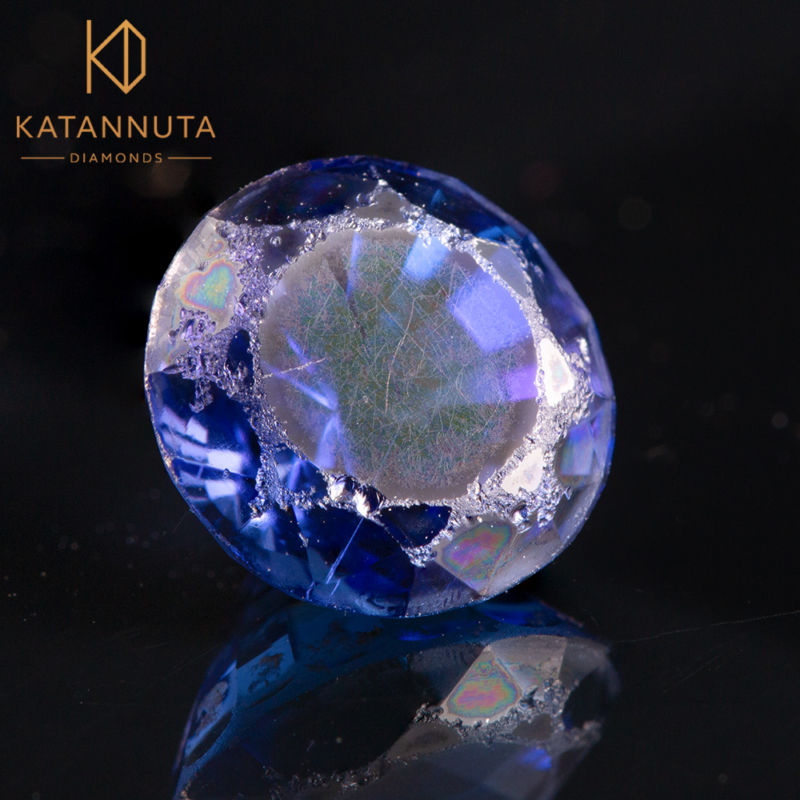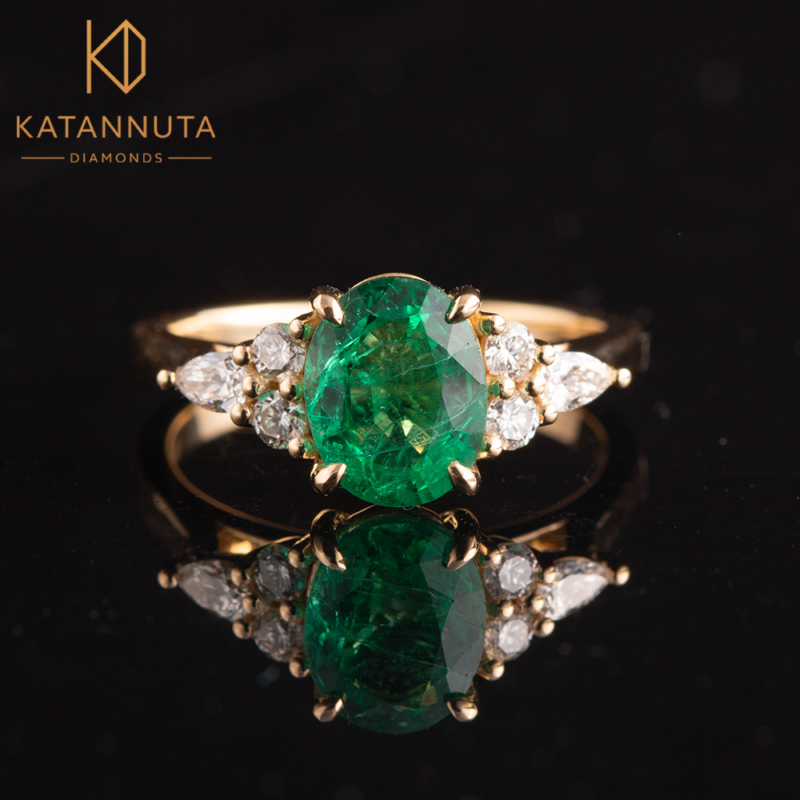When it comes to the most popular engagement rings in South Africa, diamonds are still at the top of most women’s wish list – and for good reason. Diamonds are beautiful, with a fire, brilliance and scintillation that’s difficult to beat, but they are also hard, durable and tough. In theory, your engagement ring is going to be worn every day for the rest of your life, so you need both the gemstones and ring design to be able to stand the test of time. This is one of the reasons diamonds are so popular (outside of the clever marketing started by De Beers) – they are the hardest gemstone available, with a rating of 10 (out of 10) on Moh’s hardness scale.
In recent years, there has been huge growth in alternative engagement ring designs, often featuring coloured gemstones. At Katannuta Diamonds, we encourage creativity and individuality for our clients, but we also know that nature hasn’t created all gemstones equally. Ultimately, you can choose whichever gemstone you want for your engagement (or wedding ring), but here are six popular gems that we wouldn’t personally recommend, and why.
-
Tanzanite
Of the six gemstones we will discuss, tanzanite is the most frequently requested in our engagement ring enquiries. With its velvety purples and blues, tanzanite is a stunning and uniquely African gemstone. However, beauty comes at a cost. Tanzanite has a hardness of just 6.5 to 7 on the Mohs scale, making it especially prone to scratching and chipping. Daily wear, knocks, and bumps can all cause damage, so it’s a stone that needs extra caution and care, not ideal for a ring you plan to wear every day, forever. Instead of tanzanite, we recommend sapphire or spinel (both available in blues and purples) as better engagement ring gemstones.

This 3-carat tanzanite was set in a ring worn daily for 7 years. We didn’t make the original ring, but the stone was brought to us for repairs and to be set into a pendant. Note the severe abrasion around the table and top facets of the tanzanite, together with the two deep chips at the edge of the table.
-
Emerald
Few gemstones are as iconic as emeralds, but these beautiful green gems have a well-deserved reputation for fragility. Emeralds are relatively hard (8 on the Mohs scale), but they’re also fragile due to their natural inclusions, fractures and cleavage planes. These natural internal features create weak points, making emeralds prone to chipping or cracking, especially when worn in rings. We’ve made many emerald engagement rings over the years, but we will always warn our clients about the lack of durability of emeralds. If your heart is set on a green gemstone, we’ll suggest an alternative such as green sapphire or maybe even tsavorite (green garnet).

Emeralds are noted for their frequent and common inclusions and imperfections, which can be seen easily in this stunning emerald. Be aware that emeralds are hard, but not durable, and these imperfections could make the gem susceptible to damage when worn daily.
-
Moonstone
Composed of two feldspar minerals, moonstone is easily identifiable thanks to its distinctive adularescence. This bluish-white moonlight shimmer and dreamy glow is appealing to many gemstone lovers. As one of June’s birthstones, there is sometimes a desire to incorporate it into an engagement ring. But this soft gemstone, ranking only 6 on the Mohs scale, is easily scratched and fractured. Its layered structure makes it vulnerable to cleaving or splitting upon impact. While it’s beautiful for earrings or pendants, it’s simply not tough enough for daily wear on your hands and will get damaged exceptionally easily in an engagement ring.
-
Opal
Technically, opals aren’t a mineral – they’re a mineraloid, because they lack a crystalline structure (unlike diamonds, sapphires and other gemstones). Made of amorphous, hydrated silica, opals formed from the deposition of dissolved silica as water evaporated after heavy season rains in arid areas. As such, opals have a very high water content, sometimes up to 20% of the chemical composition. Opals are beloved for their play-of-colour, caused by the refraction of light off sub-microscopic silica spheres. They are one of the softest and most fragile gemstones available, and are sensitive to sudden changes in temperature and humidity. Their 5.5-6 range of hardness, combined with their porosity, means they are prone to cracking, breaking and shattering. We think you’ll agree that those aren’t ideal properties if you want your engagement ring to last a lifetime.

These rings set with Ethiopian opals are beautiful, but cannot be worn daily as an engagement ring.
-
Pearl
Timeless and elegant, pearls are a classic choice if you’re wearing them in necklaces and earrings. Unlike most gems, pearls are not minerals, but instead are an organic gem formed by living organisms. They are incredibly soft, with a ranking of only 2.5 on the Mohs scale. As such, they are susceptible to everything from scratches to chemical damage. Daily handwashing, hand sanitiser, hand cream and other cosmetic products can dull or destroy a pearl’s lustre, making them far better suited to occasional wear than engagement rings.

If you love pearls, wear them as a necklace or a set of earrings, not as an engagement ring.
-
Moss Agate
There has been a surge in popularity in moss agate over the past few years. With its unique, organic type inclusions and affordable price point, it has appealed to many future brides. Each moss agate is one of a kind, as no two stones will have the same pattern of inclusions. Agate is a microcrystalline version of quartz, but at only 6.5–7 on the Mohs scale, we would never recommend it for daily wear. It’s a stunning and unique gemstone, but keep it for earrings and pendants where it won’t get scratched, damaged or chipped.

An AI-generated image of a cabochon moss agate style ring. Whilst this ring is purely imaginary, thanks to Chat-GPT, there are many similar moss agate rings around the world being sold as engagement rings.
Durability matters.
Ultimately, when it comes to deciding on your perfect engagement ring, durability of the gemstones and the design need to be your top priority. Trends will come and go, and whilst your tanzanite or moss agate skinny band engagement ring might look amazing for your “I said ‘Yes!’” Instagram post, it won’t look as perfect 2 years from now.
At Katannuta Diamonds, we’re all about crafting rings that last a lifetime, not just a few years. If you’d love a unique or colourful engagement ring, we’ll guide you towards the best alternatives for both your budget and your lifestyle. Want something different, but still practical? Reach out and contact us. We’ll help you make a choice you’ll love today – and 20 years from now.



![The ONLY reason to buy lab-grown diamonds [And it might not be the reason you think]](https://katannutadiamonds.co.za/wp-content/uploads/2023/11/Solitaire-lab-grown-diamond-ring-500x383.jpg)

